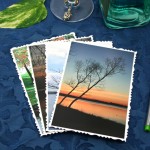
Size: 750 pieces
Available for purchase on eBay
Dimensions: 39.37 cm x 59.69 cm
Manufacturer: The Canadian Group, #44888PAL
Artist: James Coleman
Box: photo
Tag: sky
Aurora

Size: 1000 pieces
Available for purchase on eBay
Dimensions: 49 cm x 69 cm
Manufacturer: The Canadian Group, #01822
Photographer: Biletsky Evgeniy
Box: photo
Mountain cascade

Size: 1000 pieces
Available for purchase on eBay
Dimensions: 48.9 cm x 67.6 cm
Manufacturer: Cobble Hill, Item No. 80230
Artist: Mark Keathley
Box: photo
Rocky mountain reflections

Size: 500 pieces
Available for purchase on eBay
Dimensions: 49.6 cm x 62.5 cm
Manufacturer: Page Publications, ISBN: 978-1-64833-029-2
Box: photo
Puzzle: Forces of Time

Size: 1000 pieces
Dimensions: 67.95 cm x 48.1 cm
Producer: Mega Puzzles, Vibrant series, 2013, No. 51420AAN, A29073LP
Artist: Sean Bagshaw
Original: photo
Puzzle: Not a completely trivial puzzle, but due to its vibrant colours and the pieces fitting together well, it makes for an extended pleasure to assemble. The easiest region to start is the border between the rock and the sky. Sky can be completed next. The uniform areas of orange, red, and dark red can be done next. The white/blue diagonal ridges serve as guidelines, along which various layers can then be assembled. A serene puzzle to do with a good audiobook.
Notes: Sandstone layers form intricate and alien patterns of color and texture in the Vermilion Cliffs National Monument, Arizona. [Outdoor Exposure Photography site]
Puzzle: Mountain River
Size: 750 pieces
Dimensions: 48.1cm x 64.8cm
Producer: RoseArt, Borders series
Notes: I’m missing the box for this puzzle and am unable to find the real name of it. If you have that information, could you please let me know?
Puzzle: A beautiful puzzle from the Borders series (there is also the Aspen Fantasy one), unfortunately due to being quite old in my collection, it is missing a corner. Flowers in the bottom right, the river, the larger rocks, and the sky are good places to start the assembly. The mountains and the fields in the background can follow, leaving the trees framing the picture. Not a trivial puzzle due to variety of piece shapes and small detail, but very pleasant on the eye.
Photo: Young tree over Ottawa river, March 30, 2013
Photo: Trees over Ottawa river, March 30, 2013

Puzzle: The Oceanwaves Quiltscape by Rebecca Barker
Size: 1000 pieces
Dimensions: 69 cm x 51 cm
Producer: Ceaco, 2003,3307-2
Puzzle: A bright vibrant puzzle, easily done due to multiple horizontal dividers with colour variations, and the geometrical patterns. The horizon line, the boats, the big turquoise wave, and the line separating the surf and sand create several distinct regions. From there on, filling out the rest is trivial.
Notes: “Rebecca has a deep appreciation of country living and antique quilts which clearly inspires the subjects she paints today. Her paintings feature quilts accompanied by foreground or background scenes which formally illustrate the traditional names of the quilt patterns.
Rebecca’s current series is titled “Quiltscapes”. Rebecca paints her Quiltscapes in acrylic on board (masonite). The patterns come from quilt history books and she regularly attends quilt shows. Her style is realistic with clean, clear colors and a sensitivity to composition and texture.
The Oceanwaves Quiltscape: This quilt pattern has the feel of the sea right in its folds. It is one of the first authentic all pieced quilt patterns which is comprised of many small triangles. It was created around the mid or late 1800’s. Origin unknown.
“My work is meant to honor the beauty of old time quilts and their patterns.” [Rebecca Barker]” [Puzzle box]
Puzzle: Perseverance by Thomas Kinkade

Size: 750 pieces
Dimensions: 60.96cm x 60.96cm
Producer: Ceaco, No.2943-6
Artist: Thomas Kinkade
Puzzle: This puzzle was a pleasure to do: the sunlit clouds and the boat are the logical starting points, as is the horizon. The foam on the waves separates the puzzle into several smaller regions, easy to complete. The waves just below the horizon are parallel to it, making that part of the puzzle trivial to complete.
Perseverance: Perseverance is the individual’s tendency to behave without being reinforced into the motivation purposes. In psychology, perseverance is related to a non-cognitive trait. [Wiki]
Photo: Fire in the sky, August 28, 2012

Photo: Birds into clouds, August 28, 2012

Puzzle: Above the Clouds by Ciro Marchetti
 Size: 1000 pieces
Size: 1000 pieces
Dimensions: 51cm x 68cm
Producer: LPF Ltd., Holographic puzzle, #3921
Artist: Ciro Marchetti has had a successful graphic design career that has spanned working in Europe, South America and the US. He is a five-time recipient of the distinguished Photoshop GURU award, and three time winner of the Worldwide Photoshop Competition presented by the National Association of Photoshop Professionals. The current content and style of recent illustrations directly reflect his sources of interest and inspiration, allowing him to create richly detailed images that conjure up retro- tech worlds of fantasy and imagination. [Puzzle box]
Puzzle: From the same series as City of Wands, City of Coins, and Shangri-La Winter, by Ciro Marchetti.
Notes: Within the troposphere, red, orange, and pink clouds occur almost entirely at sunrise/sunset and are the result of the scattering of sunlight by the atmosphere. When the angle between the sun and the horizon is less than 10 percent, as it is just after sunrise or just prior to sunset, sunlight becomes too red due to refraction for any colors other than those with a reddish hue to be seen. The clouds do not become that color; they are reflecting long and unscattered rays of sunlight, which are predominant at those hours. The effect is much like if one were to shine a red spotlight on a white sheet. In combination with large, mature thunderheads, this can produce blood-red clouds. Clouds look darker in the near-infrared because water absorbs solar radiation at those wavelengths.
In high latitude regions of the stratosphere, nacreous clouds occasionally found there during the polar winter tend to display quite striking displays of mother-of-pearl colorations due to the refraction and diffusion of the sun’s rays through thin ice crystal clouds that often contain compounds other than water. At still higher altitudes up in the mesospere, noctilucent clouds sometimes seen in polar regions in the summer usually appear a silvery white that can resemble brightly illuminated cirrus. [Wiki]
Beading: Night Sky bookmark, silver-plated
Beading: Cloudy Sky bookmark, silver-plated
Puzzle: Constellations

Size: over 500 pieces
Dimensions: 51.43cm x 51.43cm
Producer: Springbok, Hallmark Cards Inc., #PZL2107
Notes: In modern astronomy, a constellation is an internationally defined area of the celestial sphere. These areas are grouped around asterisms, patterns formed by prominent stars within apparent proximity to one another on Earth’s night sky.
There are 88 standard constellations recognized by the International Astronomical Union (IAU) since 1922. The majority of these goes back to the 48 constellations defined by Ptolemy in his Almagest (2nd century). The remaining ones were defined in the 17th and 18th century; the most recent ones are found on the southern sky, defined in Coelum australe stelliferum by Nicolas Louis de Lacaille (1763).
There are also numerous historical constellations not recognized by the IAU, or constellations recognized in regional traditions of astronomy or astrology, such as Chinese, Hindu or Australian Aboriginal. [Wiki]
Photography cards: Sky Trees
Photography cards: Water Zen
Beading: Stormy Stars necklace
Photo: Tree-Web, March 30, 2011


































